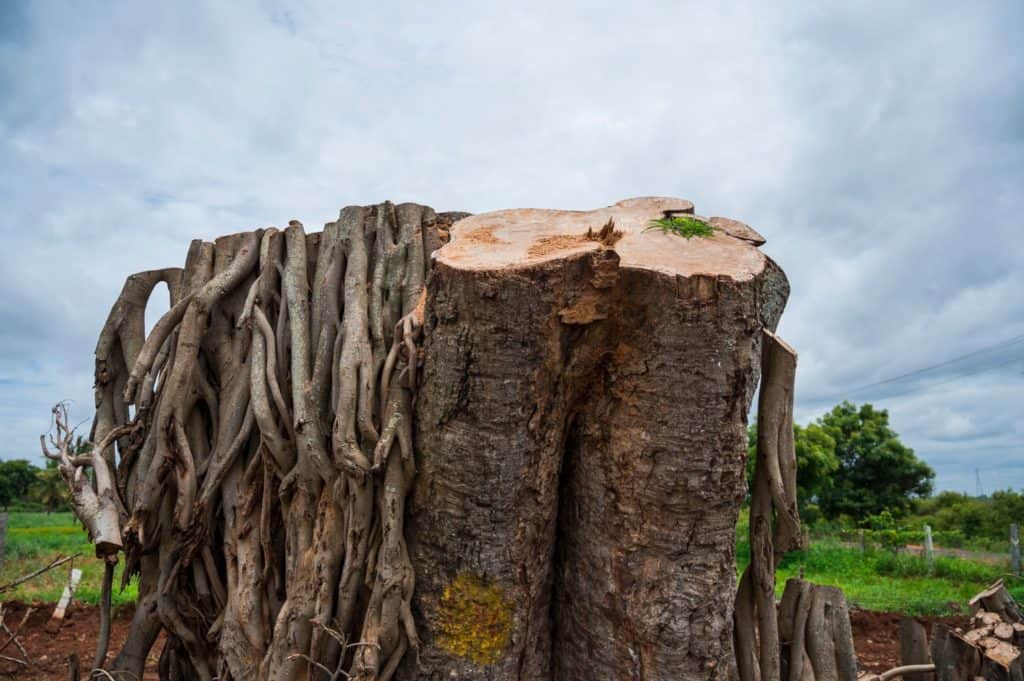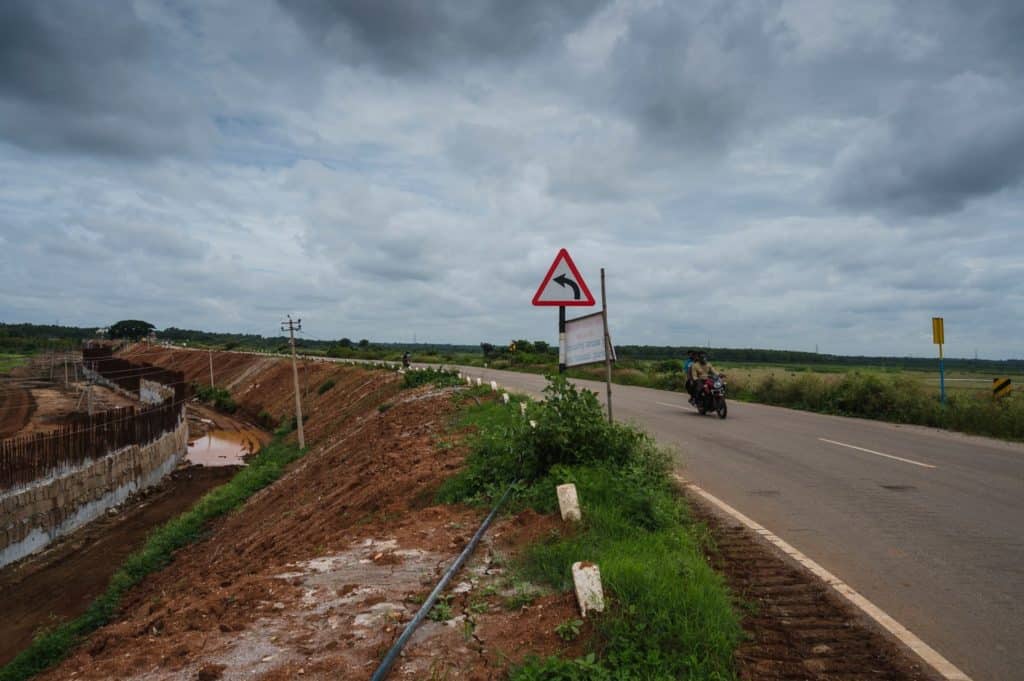[In Part 1 of this series, we saw that around 5000 trees are proposed to be axed for the ‘Bangalore Surrounding Roads Project’ but certain discrepancies hint that the actual number could be higher. In this part, we look at the project’s impacts and why citizens are worried.]
“I was in Hesaraghatta the other day and an electrician asked me why I wasn’t protesting tree felling on the Nelamangala-Doddaballapura road, just a little distance away from there. He asked me, don’t the ministers and bureaucrats need air and water too?” says Mahesh Bhat, photographer and faculty at the Srishti Institute of Art, Design and Technology.
Prompted by the chance meeting, Mahesh drove along a 6-km stretch on the Nelamangala-Madhure road that’s to be widened under the ‘Bangalore Surrounding Roads Project’. Mahesh found several large trees, including banyan trees, cut all along the stretch.
In addition to the Nelamangala-Madhure stretch, five other roads in Bangalore Urban and Rural – spanning a total length of around 155 km – are proposed to be widened under the Surrounding Roads Project. The widening is supposed to help decongest these peripheral roads and improve connectivity to the airport. The project is being implemented by Karnataka Road Development Corporation Ltd (KRDCL), which already has procured tree-felling permissions for four of the six roads.
Impacts: Pollution, heat islands, biodiversity loss
This February-March, three researchers from Azim Premji University – Seema Mundoli, Ranjini Murali and Harini Nagendra – conducted a rapid EIA (Environmental Impact Assessment) of the project. They found the project would lead to irreversible environmental damage, with four impacts in particular:
- Health hazards from pollution: Road widening will increase traffic and decrease tree cover, putting people at higher risk of PM10, PM2.5 and NOx from vehicular emissions.
- Urban heat island effect: Trees can reduce ambient air temperature on roads by as much as 5.6 degree C. Hence the loss of tree cover will contribute to rising temperatures.
- Loss of heritage trees and urban biodiversity: Endangered species such as the slender loris may lose their habitat due to fragmentation of the city’s forests.
- Impact on lakes and groundwater recharge: There needs to be a 30 m buffer zone around lakes according to Supreme Court orders. The survey says buffer zones would be encroached for road widening. Trees, especially in such buffer zones, help increase water retention.

Biodiversity loss in each of the six roads:
- Road 1 (Hoskote-Budigere Cross to Airport Road) : Species such as jamun, neem, teak, peepul, banyan to be felled.
- Road 2A (Nelamangala to Madhure): In one stretch, researchers identified 929 trees belonging to 28 different species that would be cut. One small stretch alone had 206 banyan trees, capable of supporting a wide array of biodiversity.
- Road 2B (Madhure to Devanahalli Road): A large part of the road cuts across agricultural land and lies adjacent to Junnasandra Mini Forest. The researchers spotted species like mongoose, bonnet macaques, heron and stilt along the stretch, which are likely to lose their microhabitats.
- Road 3A (Kanchugaranahalli to Jigani): The road would cut through Anekal Reserve Forest, contiguous to the Banerghatta National Park.
- Road 3B (Bannerghatta to Besthamanahalli): Many heritage trees to be cut.
- Road 4A (Besthamanahalli to Hoskote Road): Over 40 tree species recorded, including banyan, jamun, honge, flame of the forest, shivne and sissoo. Many large trees, and religious trees such as Ashwathkatte, marked to be cut.
Around 45,000 trees to go for multiple Bengaluru projects
Sandeep Anirudhan, activist and founder of Citizens’ Agenda for Bengaluru, says, that around 45,000 trees are going to be lost in and around the city for various projects. Other than the Surrounding Roads Project, he says, “there’s the shrinking of the eco-sensitive zone of Bannerghatta National Park by 100 sq km, the Peripheral Ring Road which will cost us 33,000 trees, the Metro lines which is another 4-5,000 trees.”
“It is going to be a disaster, along with other such projects,” says Prof T V Ramachandra, Centre for Ecological Sciences, IISc, “Only 3.4% of the city’s green cover is left now.” A 2019 study co-authored by Prof Ramachandra had found that the city only has around 1.5 million trees, which is insufficient to generate enough oxygen for its population of 9.5 million.
The study had also found that between 1973 and 2016, paved surfaces (mostly concrete) increased in the city by 1005%, whereas vegetation cover declined by 88%, and wetlands by 79%. He says, “We have an increasing level of greenhouse emissions, lack of oxygen, depleting groundwater reserves. What is needed is planned sustainable urbanisation, not more road-widening projects like this one.” Prof Ramachandra estimates that 98.5% of the city will be built up by 2025.
Road widening Vs Sustainable transport
Ramesh A, the Executive Engineer at KRDCL in charge of the project, says, “Our aim is to reduce congestion on the roads. The travel time has to be considered. The project will scatter traffic away from the city and reduce pollution.”
His justification for the project reflects the rationale provided in its Final Feasibility Reports (FFRs), published in the KRDCL website. However, several transport experts say that widening roads to reduce traffic is actually counter-productive.
Prof Ashish Verma, Associate Professor of Transportation Systems Engineering at IISc, explains, “This is the traditional approach from a purely engineering perspective. One looks at how much traffic a road carries, and estimates future traffic based on that data. Then you do a V (vehicular traffic)/C (width-capacity) calculation for the road [which would indicate traffic congestion]. And the traditional solution to decongestion is to increase ‘C’ – that is, the width of the road.”

He further asks, “How long can you go on increasing the road width? The sustainable solution is to reduce the traffic flow over time. Tell me, have all the new flyovers increased traffic in the city or decreased it?” Prof Ashish recommends that instead of road widening, long-term policy-based solutions should be implemented to reduce traffic flow.
However, KRDCL engineer Ramesh expresses the implausibility of such solutions ever being put into action. He says, “His [Ashish’s] perspective is correct, but is it practical to somehow reduce the number of cars in the city? We have to assume that they will increase, and widen the road.”
KRDCL started getting permissions from the Forest Department and began tree felling this March. In the meantime, citizens have registered their objections through protests, at the project’s public consultations, and even in court.
Public consultations ineffective, say activists
Though public consultations for the project were held last December and January, activists say these were ineffective. Rajani Santosh, an activist who had attended some of the consultations, says very few people had turned up, and that “these were more public declarations than consultations”. Citing the example of the consulation at Mandur, she alleges that the KRDCL and KFD officials did not take attendees’ objections seriously or respond to those.
Anthony Mariyappa, who was DCF Bangalore Rural at the time and currently is in charge of both Bangalore Rural and Urban, says, “There are some objections which don’t make practical sense. But there are some reasonable solutions too and we pass those on to the implementing agency. That’s as much as we [forest officers] can do.”.
Anthony says his priority is to save trees but, “We get the application only at the final stage, when the tree-felling permissions alone are pending. The project would have all the necessary approvals, including for land acquisition, by the time it comes to us. So we can’t change the entire plan.”
He adds that forest officers hence only have a few tools at their disposal. “Transplantation is one of those tools; we always try to reduce the number of trees cut, and recommend transplantation.” He says there may be more impediments to tree felling now since the case is in court.
Battle continues in court
This July, the KRDCL was added as a respondent to an ongoing case that demands accountability in tree felling. D T Devare and the Bangalore Environment Trust (BET) had filed a PIL (WP 17841/2018) in the High Court, praying for proper functioning of the tree authority under the Karnataka Preservation of Trees Act, 1976.
Last year, as per the directions of the High Court, an expert tree committee was constituted to make decisions on tree felling in Bengaluru. The committee is supposed to minimise the tree felling required for development projects. But in February, HC ordered that the Preservation of Trees Act is applicable only to BBMP limits, and not the whole of Bengaluru Urban and Rural districts. Since much of the Surrounding Roads Project lay outside the BBMP limits, this meant the expert committee had no role in granting permissions for it. The PIL petitioners contested this, and KRDCL was made a respondent in the case.
The case is pending even as trees are already being felled for the project. The petitioners have requested for a stay on tree felling, and KRDCL has submitted its objections to this on a hearing on August 20. The next hearing of the case is on September 3.
The government should develop a plantation in the areas near to which they plan to widen the roads. This should be done when the project is proposed, out of existing funds. As the project wounds thru the various approvals, desks, budgets, agencies, courts, environmental challenges etc., the trees would have grown up and can be shown as compensation for trees being cut. Wondering if this is do able? It would solve this kind of issues in the article, as well as ensure development.
I thought there was already technology in use in world that has the ability to move a tree.
Transplanting a tree is quite costly. I think we can plant maybe 10 trees (including looking after them for 5 yrs) within the same amount.
Essential development works is required.
In this road widening project if the authorities identify and start planting and nurture 10 times the number of trees that are being fell parallel as the project is executed, by the time the project is completed the new trees would make good the damage caused and over a period the benefits would be 20 times more than what it is today.
Only problem here is commitment by the authorities and integrity quotient to responsibility execute the plan
Please don’t cut the trees you living just because of them you can’t cut them please don’t!!
We have to plant at least 4 times the trees that are felled and the locations should be identified before the sanction. Cost of plantation to be included in the cost of project.